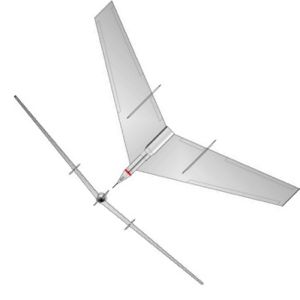
Home - Search - Browse - Alphabetic Index: 0- 1- 2- 3- 4- 5- 6- 7- 8- 9
A- B- C- D- E- F- G- H- I- J- K- L- M- N- O- P- Q- R- S- T- U- V- W- X- Y- Z
1956 Von Braun Landing Boat
 1956 vB Landing Boat 1956 Von Braun Landing Boat Credit: © Mark Wade |
Status: Study 1956. Payload: 49,000 kg (108,000 lb). Thrust: 1,470.00 kN (330,460 lbf). Gross mass: 161,000 kg (354,000 lb). Unfuelled mass: 104,600 kg (230,600 lb). Specific impulse: 297 s. Height: 22.00 m (72.00 ft). Diameter: 4.10 m (13.40 ft). Span: 137.00 m (449.00 ft).
The profile was the same, except that the ascent stage was only half the size to take the crew of 9 back to Mars orbit (as opposed to 25 in the original design). This allowed a much larger net payload to be landed on the surface, necessary since this was a single-ship mission. The enormous glider would land on Mars horizontally on skids at a location judged to be flat enough from orbital survey. The forward part of the fuselage, which formed the ascent stage, would be winched vertically for the return to the mother ships in Mars orbit after 400 days on the surface.
Since there was no back-up to the passenger ship, and quarters were cramped there, three crew members would stay aboard the cut-rate Landing Boat during the coast from earth to mars. This Landing Boat design was equipped with five rocket engines. They would fire first to deorbit the glider from the 1000 km altitude orbit of the Cargo Ship which had conveyed it to Mars. The descent profile was the same as that calculated in 1948. 9 of the expedition's 12 crew would be sent to the surface on the landing boat. After raising the forward part of the fuselage - the ascent stage - to a vertical position in case of the need for an emergency return, they would set up their Mars base. Payload included 17 metric tons of consumables and 32 metric tons of equipment, including a tractor with pressurized quarters for extended surveys of the surface, a 6-m diameter inflatable pressurized tent for surface quarters, and scientific equipment.
At the appropriate time, the crew would lift-off in the ascent vehicle and rendezvous with the seven passenger ships in orbit. The ascent stage would have a launch mass of 69 metric tons, half that of the original design. The burn into an elliptical transfer orbit and the circularization burn near the passenger ship would require 56.4 metric tons of propellant. Transfer of the 9 astronauts and 2.5 metric tons of material returned from the surface would be done between the ascent vehicle and the passenger ship using the Passenger Ship's 3.5 metric ton space boat. The ascent stage, abandoned in Mars orbit, would have an empty mass of 12.5 metric tons.
Crew Size: 9. Spacecraft delta v: 4,100 m/s (13,400 ft/sec).
Family: Mars lander. People: von Braun. Country: USA. Spacecraft: Von Braun Mars Expedition - 1956. Propellants: Nitric acid/Hydrazine. Bibliography: 49, 591.
Back to top of page
Home - Search - Browse - Alphabetic Index: 0- 1- 2- 3- 4- 5- 6- 7- 8- 9
A- B- C- D- E- F- G- H- I- J- K- L- M- N- O- P- Q- R- S- T- U- V- W- X- Y- Z
© 1997-2019 Mark Wade - Contact
© / Conditions for Use